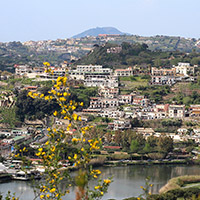Aspects of Land Take in the Metropolitan Area of Naples
Abstract
Land take is a phenomenon of great concern nowadays because of the large number of its negative impacts regarding biological, economic and social balance. In Italy, the development of urban and other artificial land has been irreversibly transforming a non-renewable resource such as soil, regardless the almost constant population rate, with different speed depending of the region considered.
The aim of this paper is to analyze the phenomenon in the metropolitan area of Naples, which is an area highly affected by territorial aggression of human matrix. The data used are both by the Institute for Environmental Protection and Research (ISPRA) Report 2015 on the usage of the land and by ISTAT relating to the resident population up to the 1st of January 2015 and the extension of land for agricultural use (Census 2010). The mathematical combination of this data creates a new indicator that can be referred to as “residual land”; this residual area is of great extension with many different characteristics and it could represent the area where the phenomenon of land take most occurs.
The identification, measurement and analysis of “residual land” provide new insights on the evolution of land take and this new indicator can represent a critical element to work on to prevent future land transformation and protect natural and agricultural areas within the Italian context.
Downloads
References
Antrop, M. (2004), Landscape Change and Urbanization Process in Europe. Landscape and Urban Planning, 67, 9-26.
Arcidiacono, A. (2011). Consumo di suolo. Il suolo, bene comune e risorsa finita. Limitare il consumo e governare l’uso. In P. Properzi (Ed.), Rapporto dal territorio 2010. Roma: INU Edizioni. 243-249.
Artmann, M. (2014). Institutional efficiency of urban soil sealing management–From raising awareness to better implementation of sustainable development in Germany. Landscape and urban Planning, 131, 83-95. DOI:10.1016/j.landurbplan.2014.07.015.
Artmann, M. (2015). Managing urban soil sealing in Munich and Leipzig (Germany) - From a wicked problem to clumsy solutions. Land Use Policy, 46, 21-37. DOI:10.1016/j.landusepol.2015.02.004.
Berdini, P. (2009). Il consumo di suolo in Italia: 1995-2006. Democrazia E Diritto. 1, 60-73.
Di Marco, M. (2010). Cosa succede al territorio dell’agricoltura. In P. Properzi (Ed.), Rapporto dal Territorio 2010, Roma: INU Edizioni. 251-256.
EC - European Commission (2006). Thematic Strategy for Soil Protection. Communication (COM(2006)231).
EC - European Commission (2011). A resource-efficient Europe - Flagship initiative under the Europe 2020 Strategy, Communication (COM(2011)21).
EEA - European Environment Agency (2015), Land take. http://www.eea.europa.eu/data-and-maps/indicators/land-take. Access 07/11/2015.
Ewing, R. (1997). Is Los Angeles-style sprawl desirable?. Journal of the American Planning Association, 63(1), 107-126. DOI:10.1080/01944369708975728.
Gibelli, M.C., Salzano, E. & Baioni M. (2006). No sprawl: perché è necessario controllare la dispersione urbana e il consumo di suolo. Firenze: Alinea.
ISPRA (2015). Il consumo di suolo in Italia. Edizione 2015. Rapporto 218. Roma: ISPRA.
ISTAT (2010). Censimento dell’agricoltura. www.istat.it.
ISTAT (2015). Popolazione residente al 31 dicembre 2014. Datawarehouse. www.istat.it.
Mazzeo, G. (2009). Dall’area metropolitana allo sprawl urbano: la disarticolazione del territorio. Tema. Journal of Land Use, Mobility and Environment, 2(4), 7-20. DOI: 10.6092/1970-9870/100.
Mazzeo, G. (2010). Remarks from the evolution of the urban system of Naples. Atti della Sesta Conferenza Nazionale INPUT 2010, Potenza, 13-15 settembre 2010. In G. Las Casas, P. Pontrandolfi, B. Murgante (Eds.), Informatica e Pianificazione Urbana e Territoriale. Melfi: Libria Editore. Vol. 3, 103-116.
Mazzeo, G. (2012). Scenario Analysis: Toward a Change in the Use of the Soil Consumption Paradigm. TeMA, Journal of Land Use, Mobility and Environment, 5(1), 21-32. DOI: 10.6092/1970-9870/746.
Munafò, M., Salvati, L., & Zitti, M. (2013). Estimating soil sealing rate at national level - Italy as a case study. Ecological indicators, 26, 137-140. DOI:10.1016/j.ecolind.2012.11.001.
Munafò, M. (2013), “Il consumo di suolo in Italia”, Urbanistica Informazioni, XXXXI-247, 19-21.
Ombuen, S. (2013), Rendita urbana, consumo di suolo, globalizzazione finanziaria. Urbanistica Informazioni, XXXXI-247, 24-25.
Papa, R., Mazzeo, G. (2014). Characteristics of sprawl in the Naples Metropolitan Area. Indications for Controlling and Monitoring Urban Transformations. ICCSA 2014, 14th International Conference, Guimarães, Portugal, June 30 - July 3, 2014, Proceedings, Part II. B. Murgante, S. Misra, A. Rocha, C. Torre, J. Rocha, M. Falcão, D. Taniar, B. Apduhan, O. Gervasi, (Eds.). Lecture Notes in Computer Science, 8580, 520-531. Springer International Publishing Switzerland. DOI: 10.1007/978-3-319-09129-7_38.
Pileri, P. (2009). “Consumo di suolo, consumo di futuro”. Urbanistica, 138, 81-117.
Rete Natura 2000 (2015). http://www.pcn.minambiente.it/viewer/index.php?project=natura. Access 20/11/2015.
Russo, L. (2014). The Effectiveness of Planning Regulation to Curb Urban Sprawl. The Case of Striano (NA). Tema. Journal of Land Use, Mobility and Environment, 7(1), 101-114. DOI: 10.6092/1970-9870/2280.
Zoppi, C., & Lai, S. (2014). Land-taking processes: An interpretive study concerning an Italian region. Land Use Policy, 36, 369-380.
Zullo, F., Paolinelli, G., Fiordigigli, V., Fiorini, L., Romano, B. (2015). Urban development in Tuscany. Land uptake and landscapes changes. Tema. Journal of Land Use, Mobility and Environment, 8(2), 183-202. DOI: 10.6092/1970-9870/2864.

Copyright (c) 2016 Tema. Journal of Land Use, Mobility and Environment

This work is licensed under a Creative Commons Attribution 4.0 International License.
Authors who publish in this journal agree to the following:
1. Authors retain the rights to their work and give in to the journal the right of first publication of the work simultaneously licensed under a Creative Commons License - Attribution that allows others to share the work indicating the authorship and the initial publication in this journal.
2. Authors can adhere to other agreements of non-exclusive license for the distribution of the published version of the work (ex. To deposit it in an institutional repository or to publish it in a monography), provided to indicate that the document was first published in this journal.
3. Authors can distribute their work online (ex. In institutional repositories or in their website) prior to and during the submission process, as it can lead to productive exchanges and it can increase the quotations of the published work (See The Effect of Open Access)
